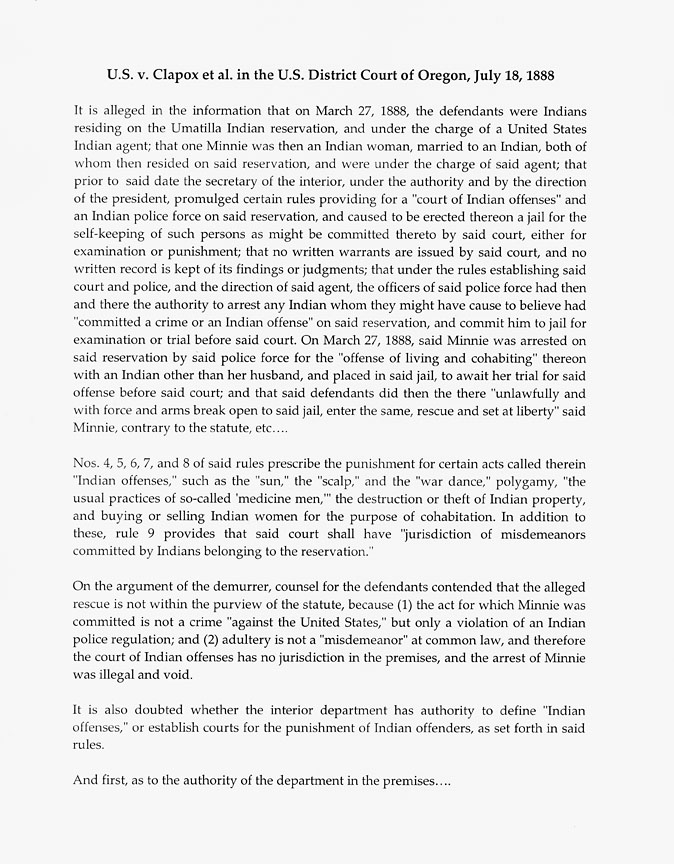- Catalog No. —
- USvC 001
- Date —
- July 18, 1888
- Era —
- 1881-1920 (Industrialization and Progressive Reform)
- Themes —
- Government, Law, and Politics, Native Americans, Oregon Trail and Resettlement
- Credits —
- Oregon Historical Society
- Regions —
- Columbia River Northeast
- Author —
- U.S. District Court of Oregon
United States v. Clapox, 1888
In March 1888, a Umatilla Indian woman known as Minnie was arrested by the Indian police and imprisoned in the reservation jail for living with a man other than her husband. A number of her friends joined together and successfully rescued her from the jail, but they were soon arrested and imprisoned. In July of that year, their case, United States v. Clapox, was heard by the federal district court of Oregon. An extract from the decision has been transcribed here.
The defense argued that Minnie’s rescuers had not committed a crime because (1) Minnie had been arrested illegally (adultery was not a federal crime), and (2) the court that had issued the order to have her arrested was itself illegal under the United States Constitution, which delegates to Congress the exclusive power to establish courts of law.
The Indian Office (forerunner of the Bureau of Indian Affairs), an executive agency, had created the courts of Indian offenses several years earlier by order of the Secretary of the Interior. These courts were designed to assimilate Native peoples into Euro-American society by outlawing traditional dances and healing ceremonies, banning polygamous marriages, and otherwise criminalizing traditional Indian cultural practices. It was under the authority of these courts that Minnie and her rescuers were arrested and imprisoned.
In U.S. v. Clapox, the federal district court agreed with the defendants that the courts of Indian offenses had no validity under the U.S. Constitution. Nevertheless, the federal district court upheld the authority of these pseudo-courts, making clear their role in the assimilation process. The courts of Indian offenses, the court argued, were “mere educational and disciplinary instrumentalities,” as were reservations. Both served only one purpose, that of instilling into Native peoples the “habits, ideas, and aspirations which distinguish the civilized from the uncivilized man.”
The ruling of the district court in this case is an excellent example of the way in which laws were used to reinforce the notion that Indians were culturally inferior peoples.
Further Reading:
Wilkins, David E. American Indian Sovereignty and the U.S. Supreme Court: The Masking of Justice. Austin, Texas, 1997.
Written by Cain Allen, © Oregon Historical Society, 2005.
